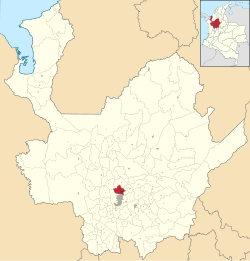Bello, Antioquia
| Bello | |||
|---|---|---|---|
| Municipality and City | |||
 |
|||
|
|||
 Location of the municipality and town of Bello, Antioquia in the Antioquia Department of Colombia |
|||
| Location in Colombia | |||
| Coordinates: 6°20′N 75°34′W / 6.333°N 75.567°W | |||
| Country |
|
||
| Founded | 1676 | ||
| Government | |||
| • Mayor | Carlos Alirio Muñoz López. 2016–2019 | ||
| Area | |||
| • Municipality and City | 142.36 km2 (54.97 sq mi) | ||
| Elevation | 1,310 m (4,300 ft) | ||
| Population (2015) | |||
| • Municipality and City | 533,973 | ||
| • Density | 3,800/km2 (9,700/sq mi) | ||
| • Metro | 3,312,165 | ||
| Demonym(s) | Bellanita | ||
| Time zone | Colombia Standard Time (UTC-5) | ||
| Area code(s) | 57 + 4 | ||
| Website | Official website (Spanish) | ||
Bello (Spanish pronunciation: [ˈbeʎo], [ˈbeʝo]) is a town and municipality in Antioquia Department, Colombia and is a suburb of Medellín, the department capital. Bello is part of The Metropolitan Area of the Aburrá Valley in the department of Antioquia. It is bordered on the north by the municipality of San Pedro de los Milagros, on the east by the municipality of Copacabana, on the south by the municipality of Medellín and on the west by the municipalities of Medellín and San Jerónimo.
The city has a population of over 500,000, making it the second largest city in the Antioquia Department after Medellín. Bello has a population density of 2496 per km. Bello is also one of several municipalities that make up part of the metropolitan area around Medellín.
Meaning "the Beautiful one" in English, Bello was founded in 1676 as "Hato Viejo" to later change its name in honor to Andrés Bello becoming a city in 1913. The city is also known as the "City of Artists" in Colombia. Its current mayor is Carlos Alirio Muñoz López.
In July 1541 troops under the command of Jerónimo Luis Tejelo (Deputy Marshal to Jorge Robledo) found the wide valley of Los Aburrá inhabited by indigenous farmers who had "a habitat organized in groups with scattered houses, forming clusters of houses". This was especially true in the town of Niquías, which occupied the territory now called Bello.
In 1574 the Spanish subject, Gaspar de Rodas, requested a land grant for the Aburrá Valley from the town hall of Santa Fe de Antioquia in order to establish therein "herds of livestock and agricultural plots", in order to provide food for the conquest. He was awarded the territories from the hill or "Asientos viejos de Aburrá" – an area which is now occupied by the Medellin town center – down, including the Niquía territory. In 1576 the captain of Rodas came to exercise control over the area from the Spanish Crown, permitting the use of the territory for corrals, ranches and flocks. From 1613 the area began to be called Hatoviejo instead of Hato de Rodas or Hato de Aburrá to distinguish it from later herds.
...
Wikipedia



